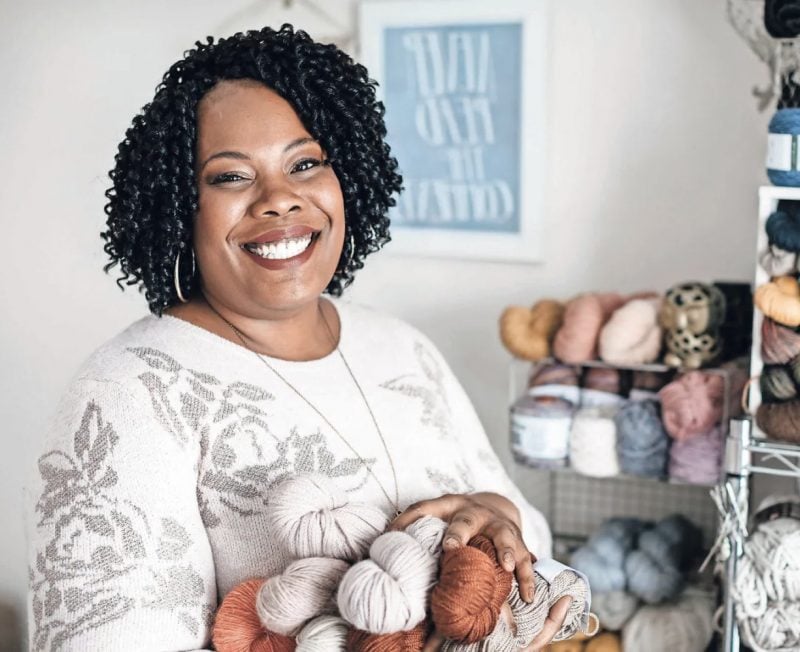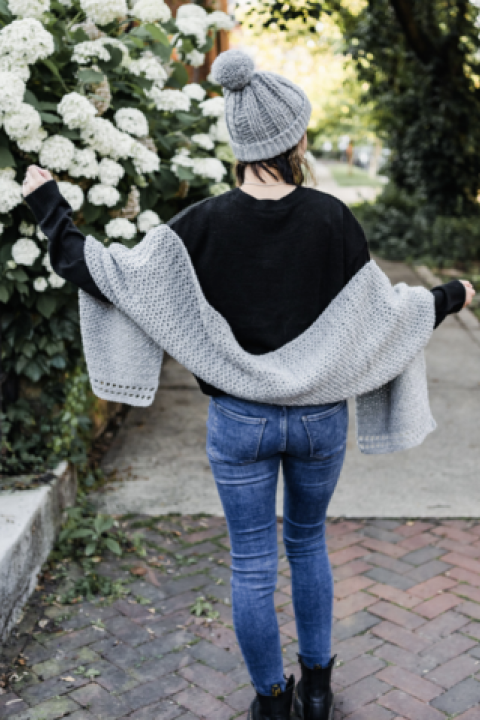Joining crochet squares, motifs, and panels is an important part of the finishing process. Seams can turn pieces of crochet fabric into blankets, sweaters, or anything else your heart desires. Bookmark this guide to 4 simple crochet seaming techniques for future use.
This post contains affiliate links that support the content on TLYCBlog.com. All opinions are my own. Find my Privacy & Disclosures Policy here.

CLICK HERE TO PIN THIS POST
Crochet seaming brings pieces together, but seams can also be decorative and worked into the visual design of a project. There are dozens of ways to join crochet fabric. I’m sharing 4 of my favorite methods here. Each one has its benefits and drawbacks. But I always find that no matter what seam I am going for, one of these four will fit the bill.
Regardless of the function your seams play, tension is the most important piece of the puzzle. Work your seams too tight and your crochet fabric will group and bunch. Work the seam too loose and your work will have gaps where the seams should be. Be mindful of your tension throughout the seam and don’t be afraid to unpick part of your seam and redo it to achieve a clean seam.
What You Will Learn
Many crochet projects from sweaters to blankets, amigurumi, and shawls will involve crochet seaming. This video will teach you 4 simple techniques that are easy for beginners to pick up on and use in their projects. Even as an experienced crocheter, I go back to these techniques again and again.
- Whip Stitch Seam: fast, easy, medium strength seam. Good for most seaming needs.
- Mattress Stitch Seam: time-consuming, nearly invisible, strongest seam with minimal flexibility. Great for garment seams under the arm and at the shoulder.
- Single Crochet Seam: slightly textured and mostly invisible. Great universal seaming technique when the wrong side of work is hidden.
- Flat Slip Stitch Seam: lovely, decorative seam when worked in a complimentary or contrasting color. Ideal for blankets.
What You Need For Crochet Seaming

Crochet seaming uses the notions you have on hand already. Hand-sewn seams can be worked with a tapestry needle. I prefer metal, as they glide cleanly through crochet fabric and won’t split the yarn. Keep scissors handy to cut the yarn before and after completing your seam. A crochet hook is needed for stitched seams but not for hand-sewn seams. Learn more about the crochet notions & accessories all makers should have on hand HERE!
Learn Crochet Seaming Techniques
Click play on the video below to learn how to do 4 common and easy crochet seams!
Practice Crochet Seaming
Now that you know the basics of crochet seams, try them out in these beginner-friendly crochet patterns:
Left: Cabana Cardi
Top Middle: LoFi Cowl
Top Right: Sandbar Cardi
Bottom: Granny Square Temperature Blanket
If you’re looking for like-minded crochet fanatics, join the TLYC Makers Facebook group. We are small but mighty and we enjoy sharing our latest projects and helping each other out. Request access to this private group HERE.









I’ve been SO looking forward to the finishing and seaming topics! I’m not new to crocheting, but had been away for a over 25 years and in my previous “crochet life” never did any blocking, and only used single crochet for seaming. Thank you for helping me to step up my game! Can’t wait to use these techniques with the upcoming CALs!!!
Oh this is great! I’ve always only slip stitch seamed, but I tended to struggle with puckering. It’s nice to have alternatives!
Whoa! Watched the video and thought the mattress seam was looking too complex. Decided to try anyway… pulling those ends and watching the bright purple yarn become INVISIBLE somehow between the 2 light blue granny squares was like absolute magic! Even my 21-year-old son was impressed!
Toni!
Thank you!
I love all these options for seaming! I’ve struggled with puckering and ugly seams, so this tutorial is just what I needed to up my game.
😊
Excited to try these! What’s your preferred method for securing the ends after joining two pieces?
Hi! I just weave the ends into the wrong side of the work 🙂
Excellent video, as expected! A couple of questions. First, when the stitches you are joining are chain stitches, are you “going around” the chain, or going between the top Vee of the chain and the back bump? Also, the joins you demonstrated are between the “tops” of stitches. How does one join the EDGES of crochet pieces? My edges seem to consist of chains and “bumps”. The bumps are generated when a turn is made with single crochet stitches. There is the final loop of the last sc, the chain one, and when turned and the hook inserted into the first space, the final loop has become a “bump” on the edge. Perhaps there is something i am not doing correctly?
what to do when corners meet using whip or mattress stitch
Thank you for the instructions. I’ve only done blankets so I’ve never had to do seams. The mattress stitch seam and the flat slip stitch seam were a little too much for me. I can see myself frogging a lot with those but the whip stitch seam and the single crochet stitch seam will be my go to’s. As always you’re a wonderful instructor.
Best video to help put squares together. I’m grateful for your help.
Another great video Toni! I have not done much seaming in crochet and the last one was new to me. Thanks for teaching me another method for making seams.
Hi Toni.
Thank you for these seam techniques. I’m not new to crochet, but it’s never too late to learn something new.
Sewing part? Not my favourite😂 That’s why I mostly avoid granny squares projects – but this summer I HAD to make one top cause I found a super duper cute pattern with grannies😍
Also, I used to make many many amigurumi (crocheted toys) and the sewing parte was always the most dangerous, it can completely change the look of those little toys, it make the success (or the failure) of the whooole project… kinda risky isn’t it?🤣
So thank you Toni, I’ll certainly watch your tutorial and I already know I’ll learn so much from your experience, as usual!
Which seaming technique is the strongest? I’m crocheting a bag done in the round and the bottom is seamed after you are finished.
For a strong seam on a bag, I’d go with the single crochet seam.
Thanks Toni. Started crocheting again this past winter after retirement. Previously I hadn’t crocheted anything in over 30 years. A lot of new things to learn and refreshers needed on others.
I’ve been making Mesa hats for our church’s Christmas fair. Instead of seaming it with the mattress stitch, as suggested in the pattern, I watched your tutorial and decided to try the flat slip stitch to add that extra row of contrast color to complete the overall pattern of the hat. I’m loving the look. Thanks, Toni, for your wonderful patterns, tips, tricks & humor. 💕
I am pleased to learn the mattress stitch seam. I never learned this one. Thank you Toni!! GO Crochet Academy 2023!
Thanks for the seaming information. I’ll be sure to use this once I make enough granny squares..
Thank you so much for this lesson, it was very helpful to me.
I have one question: When we are working into the sides of the stitches, are the techniques the same?
I would like to know this because when I tried to use the Mattress Stitch to join the 2 pieces of a bag, done in single crochet, and, when I was working into the sides of single crochet, I had great difficulty to choose where to insert the needle and I know I did not do it correctly because the result was not satisfactory.
Thanks. I like the Mattress seam. It was like it was not even there anymore. The Flat Stitch was very pretty.
I am learning so much!! I have shared the link with at least 3 friends and they are loving it too. I will be meeting you in Ann Arbor in two weeks for the Tunisian Crochet Loveland Shawl class. I teach beginning crochet and Granny Squares at Spun and rarely take a class myself. Your thoroughness is awesome! You are an inspiration.
Fondly,
Karen
I’m so excited to meet you!
Is there any need to double-up the first and last seaming stitches to secure them, just as it is done in embroidery?
Great question! Not necessarily. I will sometimes end my seams with a knot to secure them, but a tight enough seam shouldn’t budge, even without a knot.
Hi Toni.
I’m new to crocheting and been playing around for about a month and 1/2 now. I’m wondering if it ok, to use a 4 mm yarn with a 5 mm hook. Would this combo create any funny looks in the completed work?
Kind regards.
Yes, you certainly can use a 4mm hook with a yarn that calls for 5mm. It will make a tighter fabric, if that’s what you’re going for.